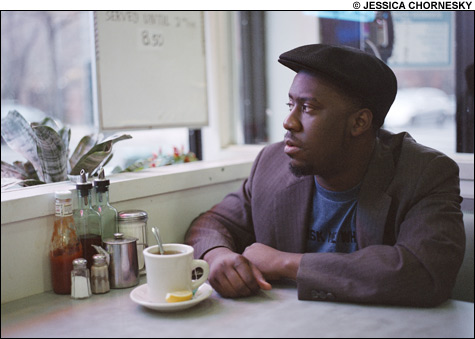
DILLA CALLING: Robert Glasper continued to emerge as a major voice. |
Here, in no particular order, are some of my favorite things from among the people, CDs, and performances I wrote about this year.
Robert Glasper
Still in his 20s, pianist Robert Glasper further established his authority with his second Blue Note album, InMy Element, whose sources extended from spirituals and the Memphis post-bop of Mulgrew Miller to J Dilla and Radiohead. Beneath the pop-tune familiarity of his pieces is a constant three-way conversation with his trio mates: the fast drum ’n’ bass patter of snare and kick from Damion Reid, lurching syncopations from bassist Vicente Arthur, Glasper stating and eliding the beat. Glasper’s transparent surfaces reveal roiling depths.

The Vandermark 5
Ken Vandermark brought his furious 5 into Johnny D’s almost exactly a year after their previous local appearance, at Hyde Park’s Artists-at-Large Gallery. With the spectacular new album A Discontinuous Line (Atavistic), they had fully assimilated their newest member, cellist Fred Lonberg-Holm. There was plenty of free blowing, but also tight unison themes for the ensemble, fiendish leaps among odd meters, and dramatic dynamic shifts that brought the music down from a shout to a whisper in a flash. Chicagoan Vandermark’s hard grooves suggest rock, but his band is one of jazz’s best.
Metheny/Mehldau
Guitarist Pat Metheny and pianist Brad Mehldau followed up their duo collaboration of 2006 with Quartet (Nonesuch) and a show at the Opera House in April. One expected killer chops (Mehldau trio members Larry Grenadier and Jeff Ballard completed the band), but not the rigor the leaders brought to the project. Instead of easy-blowing tunes, they supplied expansive narrative compositions. And their two styles complemented each other: Metheny with his taste for folk-like simplicity, Mehldau with his dense romantic complexity. It made for an exciting album, and an even better concert.
Jerry Bergonzi
The North End–born Bergonzi has been so good for so long that one tends to take him for granted. He emerged in the ’70s in a tight post-Coltrane field of tenor-saxophonists, where it was easy to get lost. But after years of gigging and teaching and achieving a near-legendary status among his peers, he put casual listeners on notice with Tenorist (Savant). Here, working with bassist Dave Santoro, drummer Adam Nussbaum, and guitarist John Abercrombie instead of a piano, he created nine hooky, concise tunes that flow with unprecedented freedom, changing up his phrasing, leaving more space, and giving loving attention to the shape and texture of individual notes.
Julius Hemphill
The music of Julius Hemphill (1938–1995) rocked the Tapestry Room of the Isabella Stewart Gardner Museum in October when his long-time companion, the esteemed pianist Ursula Oppens, joined forces with his old colleague Marty Ehrlich and the Julius Hemphill Sextet as well as the Daedelus String Quartet. Here were the twining lines of bluesy counterpoint, the driving ostinatos (especially from Alex Harding’s baritone), and the ecstastic collective improv typical of the Texas saxophonist and composer, as well as provocative through-composed chamber pieces.
Herbie Hancock
River: The Joni Letters (Verve) purports to be pianist Herbie Hancock’s tribute to the music of Joni Mitchell. But jazz fans may regard it as one of the best Herbie/Wayne Shorter albums in the careers of these long-time collaborators. Yes, there are Joni songs, and various singers (including Norah Jones, Corinne Bailey Rae, Tina Turner, and Joni herself), but the vocals are of a piece with meditative instrumental improvisations, which include non-Joni material like Ellington’s “Solitude” and Shorter’s “Nefertiti.” It could have been slick pop crossover, but this time out Herbie was hearing some deep jazz.
Musillami and Scofield
Could there have been a better night of jazz guitar than what we got October 4? First up was the Michael Musillami Trio with guest violinist Mark Feldman at MIT’s Killian Hall, working from their new Playscape release The Treatment. Musillami’s playing is effects-and-feedback-free, but his clean, dry, aggressive attack is almost rockist. He and Feldman spun free-flying improvs over tricky arrangements that made plenty of space for collective improv with bassist Joe Fonda and drummer George Schuller. John Scofield, Musillami’s conceptual opposite, loves his effects and is also capable of free-form outbursts, but he likes to start with familiar pop and R&B forms. At the Regattabar, he supplemented his trio with a three-man horn section, re-creating the fractured funk, pop, and country from his This Meets That (Emarcy).
Gypsy Schaeffer
The quartet Gypsy Schaeffer (named for a New Orleans sportin’-house proprietor) — trombonist Joel Yennior, saxophonist Andy Voelker, bassist Jef Charland, and drummer Chris Punis — suggest the sound of some of Mingus’s “pianoless” groups. There’s the free interplay of the lead horns, subtle tempo and meter shifts, and also, most surprising of all, great original tunes (not as common in jazz as you might think). A truly collective enterprise, Gypsy Schaeffer are riding on two albums, a homonymous debut and Portamental, both on the band’s own Peace Time Records.